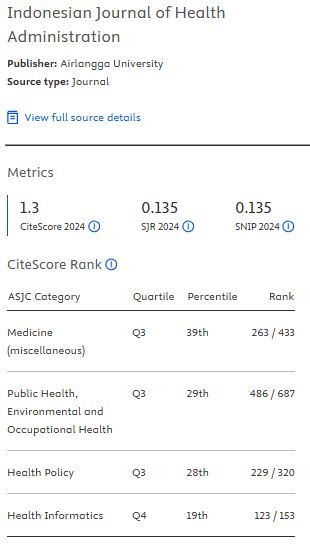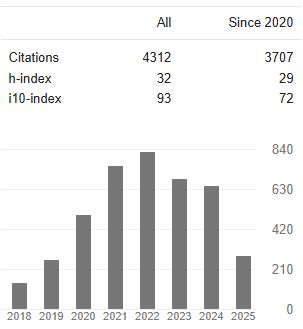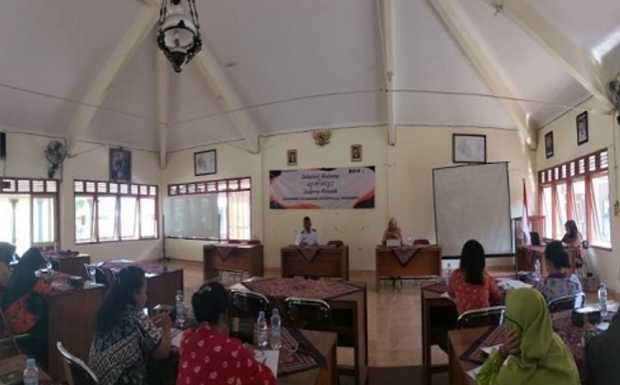PHYSIOTHERAPY SERVICE WITHOUT STANDARDIZED OPERATING PROCEDURES FROM PHYSIOTHERAPIST'S PERSPECTIVE: A CASE STUDY
Downloads
Background: Treatment variations have been considered as a sign of an inappropriate healthcare service whether due to the underuse or the overuse of resources. To reduce these variations, establishing and implementing well-developed standardized operating procedures (SOPs) and evidence-based standardized clinical guidelines is required. A rehabilitation unit for children with disabilities in Makassar did not implement any SOPs or standardized clinical guidelines in their service and treatment. This conduct may have an adverse effect on physiotherapists' professionalism.
Aims: The study aimed to explore the possible impact of community-based rehabilitation (CBR) practice with no SOPs and evidence-based standardized clinical guidelines on the physiotherapists.
Method:This study was a qualitative case study. The CBR unit was observed for 278-hours and the study conducted three semi-structured interviews. Three physiotherapists voluntarily participated in the study. Open, axial, and selective coding were conducted to encode the interview findings. The findings from observation encoded interview, field, and self-reflective notes were triangulated, analyzed thematically, and illustrated by the explorative model.
Results: Working with no SOPs and guidelines was associated with variations in procedures by physiotherapists, irregularity in their treatment choices, liability feeling toward errors making, and Low self-confidence in their professionalism.
Conclusion: Working without SOPs and guidelines was associated with psychological exertion of the physiotherapists. They showed uncertainty in their professional capabilities as a physiotherapist. It is recommended for YPAC Makassar city to develop SOPs and evidence-based standardized clinical guidelines for their organization.
Keywords: children, community-based rehabilitation, disability, guidelines, standard-operating procedure
Achu, K. et al. (2010) Introductory booklet CBR Guidelines. Edited by C. Khasnabis and K. H. Motsch. Geneva: World Health Organization Press.
Addis, S. et al. (2019) ‘Implementing Prudent Healthcare in the NHS in Wales; what are the barriers and enablers for clinicians?', Journal of Evaluation in Clinical Practice, 25(1), pp. 104–110. doi: 10.1111/jep.13023.
Arabi, Y. M. et al. (2010) ‘Mortality reduction after implementing a clinical practice guidelines-based management protocol for severe traumatic brain injury', Journal of Critical Care. Elsevier Inc., 25(2), pp. 190–195. doi: 10.1016/j.jcrc.2009.05.004.
Cleland, G., Habli, I. and Medhurst, J. (2012) Using safety cases in industry and healthcare. London: Health Foundation Evidence:
Comcec Coordination Office (2016) The Role of Community-Based Rehabilitation in Poverty Reduction : A Comparative Study among Iran , Malaysia , and Indonesia The Role of Community-Based Rehabilitation in Poverty Reduction : A Comparative Study among Iran , Malaysia , and Indonesia This re. Ankara.
Cristian, A. and Tran, A. (2012) ‘Patient Safety in Cancer Rehabilitation', 23, pp. 441–456. doi: 10.1016/j.pmr.2012.02.015.
Das, J. and Gertler, P. J. (2007) ‘Variations in practice quality in five low-income countries: A conceptual overview', Health Affairs, 26(3), pp. 296–309. doi: 10.1377/hlthaff.26.3.w296.
Fakhry, S. M. et al. (2004) ‘Management of Brain-Injured Patients by an Evidence-Based Medicine Protocol Improves Outcomes and Decreases Hospital Charges', Journal of Trauma - Injury, Infection and Critical Care, 56(3), pp. 492–500. doi: 10.1097/01.TA.0000115650.07193.66.
Hougaard, J. (2004) ‘Developing evidence-based interdisciplinary care standards and implications for improving patient safety', International Journal of Medical Informatics, 73(7), pp. 615–624. doi: https://doi.org/10.1016/j.ijmedinf.2004.04.015.
Irgens, E. L., Henriksen, N. and Moe, S. (2020) ‘Variations in physiotherapy practice in neurological rehabilitation trajectories –an explorative interview and observational study', Physiotherapy Theory and Practice. Taylor & Francis, 36(1), pp. 95–107. doi: 10.1080/09593985.2018.1480679.
Jonathan, M. (2002) Participatory Need Assessment of CBR for People with Disabilities and Community in Indonesia. Solo: PPRBM Prof. Dr. Soeharso YPAC Pusat (CBR Development and Training Center).
Jones, C. A. et al. (2016) ‘Total joint arthroplasty: practice variation of physiotherapy across the continuum of care in Alberta', BMC Health Services Research. BMC Health Services Research, 16(1), pp. 1–7. doi: 10.1186/s12913-016-1873-9.
Karnadipa, T. and Nurfikri, A. (2020) ‘Physiotherapy Service Without Documentation At A Community Based Rehabilitation For Children With Disabilities In Makassar City : A Case Study Of Physiotherapist ' S Perspective', Jurnal Sosial Humaniora Terapan, 2(2), pp. 93–100.
Kohn, L., Corrigan, J. and Donaldson, M. (2000) To Err is Human: Building a Safer Health System, Shaping the future for health.
O'Shea, Y. et al. (2006) Improving the patient journey : understanding integrated care pathways. Dublin: National Council for the Professional Development of Nursing and Midwifery.
Panella, M., Marchisio, S. and Di Stanislao, F. (2003) ‘Reducing clinical variations with clinical pathways: Do pathways work?', International Journal for Quality in Health Care, 15(6), pp. 509–521. doi: 10.1093/intqhc/mzg057.
Primadi, O. and Budijanto, D. (2014) Situasi Penyandang Disabilitas, Buletin Jendela Data & Informasi Kesehatan. Edited by R. Aprianda and F. I. Herman. Jakarta: Pusat Data dan Informasi Kementerian Kesehatan RI. doi: 10.1007/s13398-014-0173-7.2.
Reason, J. (2000) ‘Human error: Models and management', British Medical Journal, 320(7237), pp. 768–770. doi: 10.1136/bmj.320.7237.768.
Rotter, T. et al. (2012) ‘The Effects of Clinical Pathways on Professional Practice, Patient Outcomes, Length of Stay, and Hospital Costs: Cochrane Systematic Review and Meta-Analysis', Evaluation and the Health Professions, 35(1), pp. 3–27. doi: 10.1177/0163278711407313.
Shafi, S. et al. (2014) ‘Compliance with recommended care at trauma centers: Association with patient outcomes', Journal of the American College of Surgeons. American College of Surgeons, 219(2), pp. 189–198. doi: 10.1016/j.jamcollsurg.2014.04.005.
Streubert, H. J. and Carpenter, D. R. (2011) Qualitative Research in Nursing: Advancing the Humanistic Imperative. Fifth. Philadelphia: Wolters Kluwer Health.
Tracy, E. T. et al. (2010) ‘Protocolized approach to the management of congenital diaphragmatic hernia: benefits of reducing variability in care', Journal of Pediatric Surgery. Elsevier Inc., 45(6), pp. 1343–1348. doi: 10.1016/j.jpedsurg.2010.02.104.
Varkey, P., Reller, M. K. and Resar, R. K. (2007) ‘Basics of quality improvement in health care', Mayo Clinic Proceedings, 82(6), pp. 735–739. doi: 10.4065/82.6.735.
Welsh Government (2016) ‘Prudent Healthcare Securing Health and Well-being for Future Generations', Prudent Healthcare in NHS Wales, p. 23. doi: 10.1007/s11284-014-1143-4.
Woolf, S. H. et al. (1999) ‘Potential benefits, limitations, and harms of clinical guidelines', BMJ, 318(20), pp. 527–530. doi: 10.1118/1.1997631.
Yin, R. K. (2014) Case study research : design and methods. 5 edition. Los Angeles .
Zhang, A. H. and Liu, X. H. (2011) ‘Clinical pathways: Effects on professional practice, patient outcomes, length of stay and hospital costs', International Journal of Evidence-Based Healthcare, 9(2), pp. 191–192. doi: 10.1111/j.1744-1609.2011.00223.x.
Copyright (c) 2021 Triana Karnadipa

This work is licensed under a Creative Commons Attribution-ShareAlike 4.0 International License.
1. As an author you (or your employer or institution) may do the following:
- make copies (print or electronic) of the article for your own personal use, including for your own classroom teaching use;
- make copies and distribute such copies (including through e-mail) of the article to research colleagues, for the personal use by such colleagues (but not commercially or systematically, e.g. via an e-mail list or list server);
- present the article at a meeting or conference and to distribute copies of the article to the delegates attending such meeting;
- for your employer, if the article is a ‘work for hire', made within the scope of your employment, your employer may use all or part of the information in the article for other intra-company use (e.g. training);
- retain patent and trademark rights and rights to any process, procedure, or article of manufacture described in the article;
- include the article in full or in part in a thesis or dissertation (provided that this is not to be published commercially);
- use the article or any part thereof in a printed compilation of your works, such as collected writings or lecture notes (subsequent to publication of the article in the journal); and prepare other derivative works, to extend the article into book-length form, or to otherwise re-use portions or excerpts in other works, with full acknowledgement of its original publication in the journal;
- may reproduce or authorize others to reproduce the article, material extracted from the article, or derivative works for the author's personal use or for company use, provided that the source and the copyright notice are indicated.
All copies, print or electronic, or other use of the paper or article must include the appropriate bibliographic citation for the article's publication in the journal.
2. Requests from third parties
Although authors are permitted to re-use all or portions of the article in other works, this does not include granting third-party requests for reprinting, republishing, or other types of re-use.
3. Author Online Use
- Personal Servers. Authors and/or their employers shall have the right to post the accepted version of articles pre-print version of the article, or revised personal version of the final text of the article (to reflect changes made in the peer review and editing process) on their own personal servers or the servers of their institutions or employers without permission from JAKI;
- Classroom or Internal Training Use. An author is expressly permitted to post any portion of the accepted version of his/her own articles on the author's personal web site or the servers of the author's institution or company in connection with the author's teaching, training, or work responsibilities, provided that the appropriate copyright, credit, and reuse notices appear prominently with the posted material. Examples of permitted uses are lecture materials, course packs, e-reserves, conference presentations, or in-house training courses;























